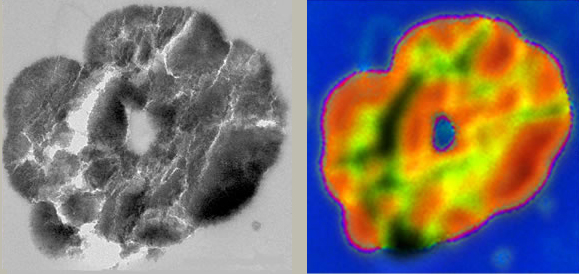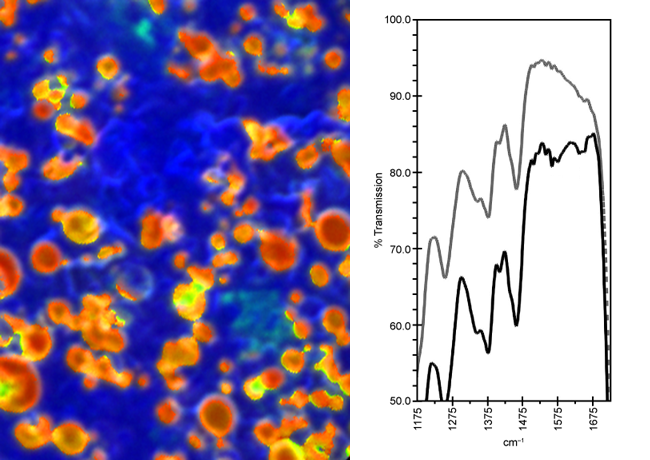Researchers from the ALS, Berkeley Lab’s National Center for Electron Microscopy (NCEM), and Lawrence Livermore National Laboratory analyzed biofilm samples rich in zinc sulfide and dominated by sulfate-reducing bacteria, which were collected from lead–zinc mine waters. The researchers were curious about the relationship of the organic material and metals, particularly how organics affect mobility, and its potential for bioremediation. It is known that some organics promote aggregation. Amine-bearing molecules, for example, can organize sulfide nanoparticles into semiconductor nanowires. The research team used a series of imaging techniques and detectors to analyze aggregates of biogenic zinc sulfide nanocrystals in the biofilms. Their examination yielded excellent results and some surprises. They were able to prove that natural organic matter promotes dense aggregation of the zinc sulfide nanocrystals into much larger spheroids and that the organic matter is preserved in nanometer-scale pores in the spheroids. What was not expected was the presence of proteins in the spheroids, making them a key component in aggregation and an example of extracellular biomineralization.

First, the researchers imaged the biofilms with transmission electron microscopy (TEM) at NCEM, finding that the zinc sulfide nanoparticles were arranged in dense aggregates. Secondary ion mass spectrometry at a spatial resolution of ~50 nm (NanoSIMS) was performed at Livermore to determine the quantitative elemental and isotopic composition of the samples’ surfaces. Nitrogen was found in the samples. A comparison of TEM images with NanoSIMS sulfur distribution maps determined that the zinc sulfide spheroids were the only structures within the biofilm containing significant sulfur concentrations. In addition, high nitrogen concentrations along the surfaces of some aggregates suggested protein-rich regions, indicating the nitrogen was organic.
The team turned to ALS Beamline 1.4 to confirm the NanoSIMS findings. Using Fourier-transform infrared spectroscopy (SR-FTIR) with a ~10-µm spatial resolution, they characterized the organics. Absorptions at ~1580 and 1640 cm–1 were associated only with the zinc sulfide spheroid-rich regions of the biofilm. These absorption features indicated amide II and amide I vibration modes, respectively, characteristic of polypeptide- and/or protein-derived amino acids, thus confirming the NanoSIMS analysis.
Polyacrylamide gel analysis of proteins extracted from the organic biofilm and the zinc sulfide spheroids suggested the nitrogen detected by NanoSIMS and SR-FTIR was associated with proteins within the mass range of bacterial proteins known to bind certain metals, and genes for these proteins have been reported in some sulfate-reducing bacteria. Therefore, the zinc-sulfide–associated proteins from these samples may serve a metal-binding function.
After confirming the existence of proteins in the spheroids, the researchers sought to understand which amino acids are involved. Aggregation experiments were performed involving synthetic zinc sulfide nanoparticles and several amino acids. The researchers found that the presence of cysteine, a building block for most proteins, yielded the most extensive and prolonged aggregation, with some aggregates measuring ten microns in diameter.
Biominerals (mineral–protein mixtures) normally form within organisms. These biomineral spheroidal aggregates, however, occurred as far as hundreds of microns from the microbial cell. The cause for this is not clear. Proteins, peptides, and amino acids could be released after cell death and scavenged by hydrophobic zinc sulfide surfaces. Alternatively, bacteria may export zinc-binding proteins for a physiological reason. Most known bacterial metal-binding proteins are produced for intracellular binding and the export of toxic metals. In this case, biofilm proteins may have bound excess aqueous Zn2+ or interacted with bound Zn(II) and other proteins after zinc sulfide precipitation. With both scenarios, external aggregation of metal–sulfide nanoparticles is promoted.
Even with these unanswered questions, the results are exciting in that they suggest an avenue for bioremediation of the most dangerous and difficult-to-remediate hazardous waste: the use of microbially derived extracellular proteins to limit the dispersal of nanoparticulate metal-bearing phases that may otherwise be transported away from their source by subsurface fluid flow.

Contact: John Moreau
Research conducted by J.W. Moreau (University of California, Berkeley), P.K. Weber and I.D. Hutcheon (Lawrence Livermore National Laboratory), M.C. Martin and B. Gilbert (Berkeley Lab), and J. Banfield (University of California, Berkeley, and Berkeley Lab).
Research funding: U.S. Department of Energy, Office of Basic Energy Sciences (BES), and Environmental Research Genomics Genomes to Life Research Program; NASA Astrobiology Institute. Operation of the ALS is supported by BES.
Publication about this research: J.W. Moreau, P.K. Weber, M.C. Martin, B. Gilbert, I.D. Hutcheon, and J.F. Banfield, “Extracellular proteins limit the dispersal of biogenic nanoparticles,” Science 316, 1600 (2007).
ALS SCIENCE HIGHLIGHT #152